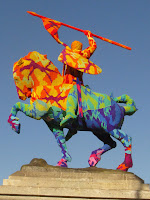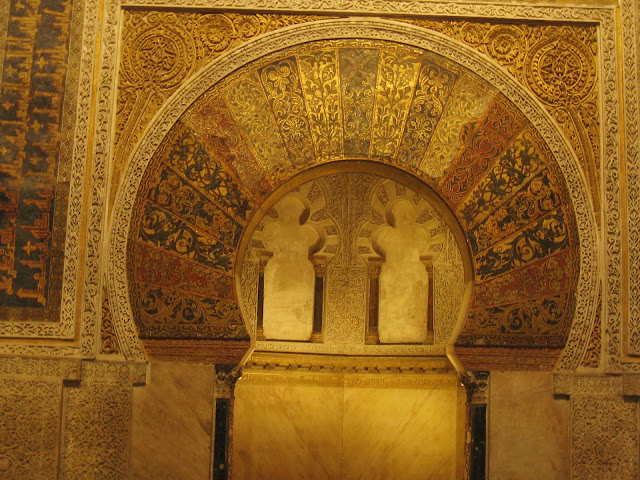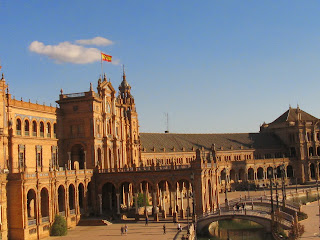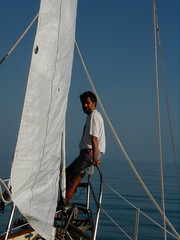 Happy to leave Cordoba and its cool weather for sunny and warmer Malaga, we went back to the »malaga market for more seafood and on that evening, our last evening in Spain, heiner managed to bring us to the Taberna Los Gatos for an excellent tapas and beer dinner...It is quite challenging to find one's way in Spanish cities..with streets name changing at every corner... But we found Los Gatos after meandering in Malaga's street and we enjoyed its atmosphere and its delicious food!
Happy to leave Cordoba and its cool weather for sunny and warmer Malaga, we went back to the »malaga market for more seafood and on that evening, our last evening in Spain, heiner managed to bring us to the Taberna Los Gatos for an excellent tapas and beer dinner...It is quite challenging to find one's way in Spanish cities..with streets name changing at every corner... But we found Los Gatos after meandering in Malaga's street and we enjoyed its atmosphere and its delicious food!Wednesday, November 27, 2013
 Happy to leave Cordoba and its cool weather for sunny and warmer Malaga, we went back to the »malaga market for more seafood and on that evening, our last evening in Spain, heiner managed to bring us to the Taberna Los Gatos for an excellent tapas and beer dinner...It is quite challenging to find one's way in Spanish cities..with streets name changing at every corner... But we found Los Gatos after meandering in Malaga's street and we enjoyed its atmosphere and its delicious food!
Happy to leave Cordoba and its cool weather for sunny and warmer Malaga, we went back to the »malaga market for more seafood and on that evening, our last evening in Spain, heiner managed to bring us to the Taberna Los Gatos for an excellent tapas and beer dinner...It is quite challenging to find one's way in Spanish cities..with streets name changing at every corner... But we found Los Gatos after meandering in Malaga's street and we enjoyed its atmosphere and its delicious food!
The last station of our Andalousian trip: Cordoba.
Again the Rio Guadalquivir is part of the city landscape...
And what about this restored Islamic water wheel that once would have raised water to the caliph's palace...


Our main goal in Cordoba, however, was to see the Mezquita: we had seen photos of this moorish-christian temple and found it stunning. We were going to be rewarded for braving the cold Cordoba weather....(6C at night).

The temple was beyond our expectations. We both agreed that we never had seen such a jewel of a church.
 Cordoba was placed under the control of Abd ar-Rahman I in 756. He was the sole survivor of the Umayad dynasty and proved to be a firm but moderate ruler establishing control over all but the north of Spain. Following the Islamic invasion, the Muslims proceeded to the demolition of the church of San Vincente (see remains in photo on the left) and proceeded to the construction of what was going to become the most important sanctuary of Western Islam.
Cordoba was placed under the control of Abd ar-Rahman I in 756. He was the sole survivor of the Umayad dynasty and proved to be a firm but moderate ruler establishing control over all but the north of Spain. Following the Islamic invasion, the Muslims proceeded to the demolition of the church of San Vincente (see remains in photo on the left) and proceeded to the construction of what was going to become the most important sanctuary of Western Islam.
The Mezquita was going to go through further stage of construction and modifications, with each follower of Abd ar-Rahman I adding new aisles and extending its walls. And in 1236, when the Christians (King Ferdinand III called El Santo) reconquered Spain, the temple was to go through further transformation. And so, Christian styled chapels, transepts, choirs and chapels were amalgamated into the mosque with an extraordianry result of an exquisite beauty.
 After spending many hours in the Cathedral, we were drawn outside and enjoyed a couple of drinks on a little Plaza close to a restaurant El patio de la Juderia where there were nightly Flamenco shows...that evening, we made our way to that restaurant in order to celebrate our last evening in Cordoba with a wonderful dinner and a very good flamenco presentation.
After spending many hours in the Cathedral, we were drawn outside and enjoyed a couple of drinks on a little Plaza close to a restaurant El patio de la Juderia where there were nightly Flamenco shows...that evening, we made our way to that restaurant in order to celebrate our last evening in Cordoba with a wonderful dinner and a very good flamenco presentation.
Again the Rio Guadalquivir is part of the city landscape...
And what about this restored Islamic water wheel that once would have raised water to the caliph's palace...


Our main goal in Cordoba, however, was to see the Mezquita: we had seen photos of this moorish-christian temple and found it stunning. We were going to be rewarded for braving the cold Cordoba weather....(6C at night).

The temple was beyond our expectations. We both agreed that we never had seen such a jewel of a church.
 Cordoba was placed under the control of Abd ar-Rahman I in 756. He was the sole survivor of the Umayad dynasty and proved to be a firm but moderate ruler establishing control over all but the north of Spain. Following the Islamic invasion, the Muslims proceeded to the demolition of the church of San Vincente (see remains in photo on the left) and proceeded to the construction of what was going to become the most important sanctuary of Western Islam.
Cordoba was placed under the control of Abd ar-Rahman I in 756. He was the sole survivor of the Umayad dynasty and proved to be a firm but moderate ruler establishing control over all but the north of Spain. Following the Islamic invasion, the Muslims proceeded to the demolition of the church of San Vincente (see remains in photo on the left) and proceeded to the construction of what was going to become the most important sanctuary of Western Islam.The Mezquita was going to go through further stage of construction and modifications, with each follower of Abd ar-Rahman I adding new aisles and extending its walls. And in 1236, when the Christians (King Ferdinand III called El Santo) reconquered Spain, the temple was to go through further transformation. And so, Christian styled chapels, transepts, choirs and chapels were amalgamated into the mosque with an extraordianry result of an exquisite beauty.
 After spending many hours in the Cathedral, we were drawn outside and enjoyed a couple of drinks on a little Plaza close to a restaurant El patio de la Juderia where there were nightly Flamenco shows...that evening, we made our way to that restaurant in order to celebrate our last evening in Cordoba with a wonderful dinner and a very good flamenco presentation.
After spending many hours in the Cathedral, we were drawn outside and enjoyed a couple of drinks on a little Plaza close to a restaurant El patio de la Juderia where there were nightly Flamenco shows...that evening, we made our way to that restaurant in order to celebrate our last evening in Cordoba with a wonderful dinner and a very good flamenco presentation. 
 On Saturday, we went on the look out for a dynamic market place....we decided to look for the Feria Mercado but were disappointed in the lack of atmosphere..nothing to compare with what we had experienced in Malaga...nevertheless, we had discovered yet another barrio of Sevilla: la Macarena with its massive Roman walls and its pittoresque shops..like this sombrero shop.
On Saturday, we went on the look out for a dynamic market place....we decided to look for the Feria Mercado but were disappointed in the lack of atmosphere..nothing to compare with what we had experienced in Malaga...nevertheless, we had discovered yet another barrio of Sevilla: la Macarena with its massive Roman walls and its pittoresque shops..like this sombrero shop.Coming back to the city centre, we stopped at one of our favorite outside bats located just in front of the marvelous Iglesia Salvador.(Here, saints and even the Virgin Mary are part of daily life...Photographs, or sculptures often ornament restaurants and even bars). The beer was cheap (1euro) which expleins the crowds, at any given time of the day...except Sundays...Saints and bar owners must take a little break, once in a while!
As for the marvelous baroque church of Salvador (the second largest church in Sevilla after the Cathedral) , it was erected on land occupied by the first mosque in Sevilla (829-830). We found its interior stunning.

 Another interesting visit was at the General Archives of the Indies. an impressive site located close to the cathedral. This beautiful example of Spanish Renaissance architecture was designed by Juan Herrera and is the repository of extremely valuable achival documents illustrating the history of Spanish naval expeditions to the Americas and the Philippines. Basiclaly, original documents such as mariners logbooks, crew lists, boat rations, EVERYHTING is kept here in their original format...The exhibition on display was entitled Pacifico: Spain and the adventure of the South sea: we were fascinated by the documents themselves and the building hosting them!
Another interesting visit was at the General Archives of the Indies. an impressive site located close to the cathedral. This beautiful example of Spanish Renaissance architecture was designed by Juan Herrera and is the repository of extremely valuable achival documents illustrating the history of Spanish naval expeditions to the Americas and the Philippines. Basiclaly, original documents such as mariners logbooks, crew lists, boat rations, EVERYHTING is kept here in their original format...The exhibition on display was entitled Pacifico: Spain and the adventure of the South sea: we were fascinated by the documents themselves and the building hosting them!
And then it was Sunday...In Spain, Sunday is family day and all the stores close in the afternoon ...streets become unusually quiet..On Sunday morning, after our first breakfast, we elected a visit at the Museum of Fine Arts as well as the Art flea market - basically, artists bring their paintings or sculptures in the garden close to the museum and hope for buyers. There was a realxed atmosphere and we enjoyed looking at local artists and their work. We expected more of the Museum itself, espcially after reading that it was the second in importance in Spain after Madrid's Prado. Oh well...Another later, we were back on the street in search of our second breakfast. Their coffee -doble espresso con leche sin azucar - is so good! as a breafast special, one is offered half a toast (longish bread) with puried tomatoe and olive oil...we chose the croissant option!
Undeterred in our artistic Sunday expedition, we then proceeded to walk to the Museum of Contemporary art, housed in another Carthusian monastery...this was located in an area that we had not yet explored.
 We found the site intriguing...with its massive monastery and the orange gardens...hundred of orange trees loaded with big fruits. And once again, irrigation canals, moorish style, giving an element of distinction to the gardens. Did we eat oranges? YES!!!!!!!!!!!!!
We found the site intriguing...with its massive monastery and the orange gardens...hundred of orange trees loaded with big fruits. And once again, irrigation canals, moorish style, giving an element of distinction to the gardens. Did we eat oranges? YES!!!!!!!!!!!!!In the mean time, it was about 14h, and local families were entering the grounds of the Cartuja with children and dogs..all sampling the fruits. When in Spain, do like the Spaniards...the fruit tasted wonderful! We got enough vitamin C for the rest of our stay!
We also discovered that its intriguing chimneys and its numerous mosaics were related to its past (or present?) vocation as a manufacture of ceramic products.
Anyhow, the sun was warm, the oranges tasted good, and we decided to skip the museum itself...prefering strolling in its gardens.

All these sevillan impressions will stay with us a long time!
Adios!
 Sevilla has many interesting promenades, plazas, paseo and parks... but our next sightseeing "must" was Plaza de Espana. We walked along the shores of the Guadalquivir river...this 657 km long river is one of the longest in Spainhttp://en.wikipedia.org/wiki/Guadalquivir.
Sevilla has many interesting promenades, plazas, paseo and parks... but our next sightseeing "must" was Plaza de Espana. We walked along the shores of the Guadalquivir river...this 657 km long river is one of the longest in Spainhttp://en.wikipedia.org/wiki/Guadalquivir.We enjoyed walking under the lush trees, also enjoying the view of Triana,a less touristic area (barrio) which used to be the heart of the gypsies communities) and where we spent quite a bit of time, in day and nighttime!

Before we get to the Plaza de Espana, we stumble upon the Torre del Oro. First erected during the moorish dynasty, this towers enabled the control of the traffic on the Guadalquivir river. It was once covererd with golden tiles..hence its name. When Sevilla was the main seaport, for Spain's expeditions to the Americas, it is at the feet of this massive tower that the gold and other treasures were unloaded... It is now a Naval museum.
And then there is the Tobacco Fabric...or Antigua Fabrca de Tabacos. This was built in 1750 and one of the largest building in Spain. After its peak in the following century, it became a tobacco factory employing more than 4000 women ...An interesting anecdote can be found in the guide namely a citation referring to the fact that female workers were minutely searched before leaving their workplace "..for they sometimes carried the filthy weed in a manner her most Catholic majesty never dreamed of" ...today's mules for drug smuggling is not a new invention!!!!
Finally we arrive to Plaza de Espana and we are speechless for a couple of seconds...
Such splendid buildings were erected in 1929 for the Spanish-America pavillion of the World's fair. The buildings were to host exhibits of industry and various crafts in Spain.
 Believe it or not, despite our 6 to 8 hours a daily walking, we found the energy to take part of the Sevillan night life...and we really mean night life! Flamenco shows began after 23h00 some at 12h30 even... Seville has an amazing amount of flamenco bars but some of them were closed...november is not a touristy month and they might have closed for the rest of the year? Nevertheless, we went on two occasions to La Carboneria (it used to be a coal merchant building) for Flamenco music and dancing and on Saturday night, we were part of a local crowd in a "flamenco disco" ...the flamenco style is very very popular in Sevilla and so, as soon as a guitar plays, you see all the hands going up, flamenco style, and the clapping of hands...spontaneously. We had a great time at both places.
Believe it or not, despite our 6 to 8 hours a daily walking, we found the energy to take part of the Sevillan night life...and we really mean night life! Flamenco shows began after 23h00 some at 12h30 even... Seville has an amazing amount of flamenco bars but some of them were closed...november is not a touristy month and they might have closed for the rest of the year? Nevertheless, we went on two occasions to La Carboneria (it used to be a coal merchant building) for Flamenco music and dancing and on Saturday night, we were part of a local crowd in a "flamenco disco" ...the flamenco style is very very popular in Sevilla and so, as soon as a guitar plays, you see all the hands going up, flamenco style, and the clapping of hands...spontaneously. We had a great time at both places.
Sevilla's cathedral was conceived in 1402 with the idea that this building would be so magnificient that posterity would believe that the builders were mad...indeed, it is of humongous proportions: it is the largest Gothic church in the world...
 There are treasures of amazing values in the Cathedral Sacristy: for example, the keys presented to Fernando King of Spain by Moorish communities on the surrender of the city. In one of the keys, there is an Arabic script sculpted in the metal: May Allah render eternal the dominion of Islam in this city...
There are treasures of amazing values in the Cathedral Sacristy: for example, the keys presented to Fernando King of Spain by Moorish communities on the surrender of the city. In one of the keys, there is an Arabic script sculpted in the metal: May Allah render eternal the dominion of Islam in this city...
 And what about this silver monstrance (ostensorio in spanish) made of silver? which is carried out of the Cathedral on certain days...Looking at all this wealth, we could not forget that gold and silver came from America and that thousands of Indians died in the process of this Spanish conquest of THEIR land and riches...there was no mention of that anywhere, of course.
And what about this silver monstrance (ostensorio in spanish) made of silver? which is carried out of the Cathedral on certain days...Looking at all this wealth, we could not forget that gold and silver came from America and that thousands of Indians died in the process of this Spanish conquest of THEIR land and riches...there was no mention of that anywhere, of course.
A very popular site in the catheral is the monument to Christopher Columbus: The coffin is held aloft by 4 huge allegorical figures representing the kingdoms of Leon, Castile, Aragon and Navarra.
Originally, the remains of Colomb were interred in the cathedral of Havanna. When Cuba declared its independence in 1902, Spain insisted for the remains of the mariner to be transferred to Sevilla. In 2002, researchers from the university of Granada carried out DNA tests in order to verify the authenticity of the remains..the tests proved inconclusive. Nevertheless, this sepulchre is of great beauty...
After the visit of this imposing monument, we went on to the Giralda, the most significant building in Sevilla.
The Giralda towr was first a mosque's minaret and the artistic pinnacle of Almohad architecture. It served as model for other minaret towers in the islamic world as in Rabat and Marrakech.
Used as a minaret as well as an observatory, the tower's 35 gently inclined ramps enabled the muezzin to ride, on his horse, to the top of the tower.... We did not have a horse..so guess what! we walked. We were lucky with the exterior temperature being around 20C...with 40C plus, it would not be an easy climb...
When the Christian reconquered the city, the Moors expressed the wish to destroy their wonderful minaret: the then King warned them that if they removed on stone of the tower, they would all be put to sword...and so, the moorish tower became the bell tower of a Christian cathedral...
Both the Cathedral and the Giralda are UNESCO monuments...http://whc.unesco.org/en/list/383/
 There are treasures of amazing values in the Cathedral Sacristy: for example, the keys presented to Fernando King of Spain by Moorish communities on the surrender of the city. In one of the keys, there is an Arabic script sculpted in the metal: May Allah render eternal the dominion of Islam in this city...
There are treasures of amazing values in the Cathedral Sacristy: for example, the keys presented to Fernando King of Spain by Moorish communities on the surrender of the city. In one of the keys, there is an Arabic script sculpted in the metal: May Allah render eternal the dominion of Islam in this city... And what about this silver monstrance (ostensorio in spanish) made of silver? which is carried out of the Cathedral on certain days...Looking at all this wealth, we could not forget that gold and silver came from America and that thousands of Indians died in the process of this Spanish conquest of THEIR land and riches...there was no mention of that anywhere, of course.
And what about this silver monstrance (ostensorio in spanish) made of silver? which is carried out of the Cathedral on certain days...Looking at all this wealth, we could not forget that gold and silver came from America and that thousands of Indians died in the process of this Spanish conquest of THEIR land and riches...there was no mention of that anywhere, of course.Originally, the remains of Colomb were interred in the cathedral of Havanna. When Cuba declared its independence in 1902, Spain insisted for the remains of the mariner to be transferred to Sevilla. In 2002, researchers from the university of Granada carried out DNA tests in order to verify the authenticity of the remains..the tests proved inconclusive. Nevertheless, this sepulchre is of great beauty...
After the visit of this imposing monument, we went on to the Giralda, the most significant building in Sevilla.
The Giralda towr was first a mosque's minaret and the artistic pinnacle of Almohad architecture. It served as model for other minaret towers in the islamic world as in Rabat and Marrakech.
Used as a minaret as well as an observatory, the tower's 35 gently inclined ramps enabled the muezzin to ride, on his horse, to the top of the tower.... We did not have a horse..so guess what! we walked. We were lucky with the exterior temperature being around 20C...with 40C plus, it would not be an easy climb...
When the Christian reconquered the city, the Moors expressed the wish to destroy their wonderful minaret: the then King warned them that if they removed on stone of the tower, they would all be put to sword...and so, the moorish tower became the bell tower of a Christian cathedral...
Both the Cathedral and the Giralda are UNESCO monuments...http://whc.unesco.org/en/list/383/
Subscribe to:
Comments (Atom)







































